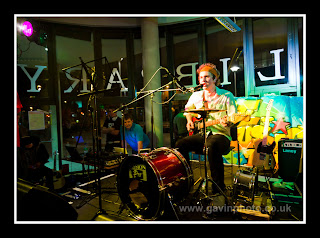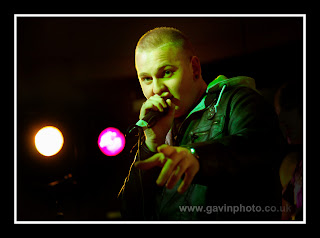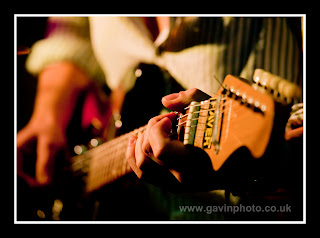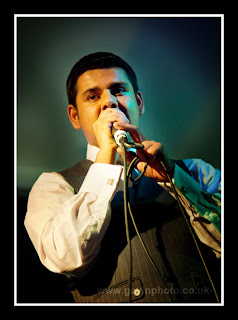 Following on from a recent post I made on Facebook and FlickR there was a lot of photographers all asking a very similar question… Getting great shots in low light, what’s my technique.
Following on from a recent post I made on Facebook and FlickR there was a lot of photographers all asking a very similar question… Getting great shots in low light, what’s my technique.Lets start with the photo to the the right. It’s a wide shot which was taken at a recent gig in a local library. It's not a great shot but I wanted to give you an idea of the situation I found myself in. The only light in all the photos in this post came from six small “disco” lights either side of the stage, which went on and off at random intervals.
Now library and gig aren’t words I’d normally put together and sure enough it was a bit of a weird event, but that’s a whole other story. No this was a classic low light situation where I had to nail the shot without resorting to flash and without using a tripod.
 Gear guide:
Gear guide:Now normally I tell people that equipment really isn’t that important, it’s the person behind the camera that makes the image. Now whilst that’s true, low light photography is one of the exceptions to that rule. Gear really does make a difference when there’s very little light and every shot is hand held.
Camera Body:
When it comes to low light photography you’ll need a DSLR if you’re going to capture quality shots.
Almost any DSLR camera body will be OK in low light, but I love my Canon 5D mark 2. One of it’s party pieces is it’s ability to shoot at very high ISO. For example many of these images were shot at 3200 iso which is at the upper limit I will use with the knowledge that the noise levels will be acceptable. The 5D is also a full frame DSLR camera which means it’s performance at high ISO’s is exceptionally good and by good I mean 3200 ISO show the same amount of noise as my older Canon 40D at 800 ISO.
 Lens Choice:
Lens Choice:The lens you use is probably more important then the camera for this type of low light work. I Used my favourite Canon 24-105L lens for most of these shots it has a maximum aperture of f/4 which means it lets in a pretty decent amount of light and that keeps the shutter speed up. It’s image stabilised to further reduce camera shake (but not motion blur) and it’s focus is fast and accurate.
For the really close up shots I switched to a Canon 70-300 IS lens. It’s a bit of a budget lens and zoomed in, only has a maximum aperture of f/5.6, but the image stabilisation is very good.
Camera Settings:
Other tips I can offer would be use Aperture priority mode and keep the aperture wide open to maximise shutter speed and minimise blur from both camera shake and motion blur.
 Use continuous shooting to get a series of shots and capture great expressions like this.
Use continuous shooting to get a series of shots and capture great expressions like this.Auto ISO is also a handy feature. Now normally I avoid auto features at all costs, but if you know you’re going to be shooting at the cameras maximum ISO (as I was here) auto ISO will drop the ISO if and when the lighting improves.
Finally
If you are faced with shooting a music gig in a library, don’t panic. It may not be Glastonbury music festival but great photos are there to be captured, just like these.
FOLLOW UP:
A couple of questions have come up on post processing. All these shots have been processed in Lightroom. This would include sharpening & noise reduction as well as colour & contrast adjustment.
However don't confuse adjustment with "make over" as very little needed to be altered from the "as shot" originals. In fact the 400+ shots taken on the night we're sorted, adjusted and the best emailed to the relevant media organisations with in 60 minutes of getting home.

3 comments:
I really appreciate this, Gavin. I was assigned to do some night action photography at an event and totally failed to get anything usable. Next year I will try using auto ISO and see what happens.
Hi Gavin, I'm just starting out in Photography (20 years in I.T is enough). I recently did a shoot for some teenage girls that wanted to go outside. I too was using a 5D mk II. My problem is the autofocus. It just would not work properly in low light. Do you have any tips apart from using a flash as they were mounted off camera(pocket wizard) and were pointing into an umbrella. I ended up using manual focus and guessing the distance.
Hi Gavin. I'm a big fan. Just thought I'd throw in my two cents. Another option is to use a flash (preferably off camera) at a low power but to set the shutter speed on the camera for longer than you expect for the flash, 1/4 sec for example. This will give you a well-lit subject and also capture the background lighting and colour (although it may be blurred if you are not using a tripod!). This is the best way to do it if the light levels are just too low for your gear. It is especially useful at gigs or nightclub events.
Post a Comment